#Galls (Botany)
Text

It’s Tell a Friend Friday!
Please enjoy this photo I took of a an oak leaf featuring a very fuzzy gall made--unsurprisingly--by an oak gall wasp! the female wasp lays an egg in the leaf of an oak tree, which triggers the growth of the gall. The wasp larvae can then live inside the gall feed on it until they are ready to emerge as adults.
Then tell someone you know about my work–you can reblog this post, or send it to someone you think may be interested in my natural history writing, classes, and tours, as well as my upcoming book, The Everyday Naturalist. Here’s where I can be found online:
Website - http://www.rebeccalexa.com
Rebecca Lexa, Naturalist Facebook Page – https://www.facebook.com/rebeccalexanaturalist
Tumblr Profile – http://rebeccathenaturalist.tumblr.com
BlueSky Profile - https://bsky.app/profile/rebeccanaturalist.bsky.social
Twitter Profile – http://www.twitter.com/rebecca_lexa
Instagram Profile – https://www.instagram.com/rebeccathenaturalist/
LinkedIn Profile – http://www.linkedin.com/in/rebeccalexanaturalist
iNaturalist Profile – https://www.inaturalist.org/people/rebeccalexa
Finally, if you like what I’m doing here, you can give me a tip at http://ko-fi.com/rebeccathenaturalist
#oak gall wasps#oak galls#oak#oak trees#oak leaves#wasps#Hymenoptera#insects#invertebrates#arthropods#plants#trees#botany#Quercus#Tell a Friend Friday#nature#wildlife
22 notes
·
View notes
Text
making oak gall ink!!
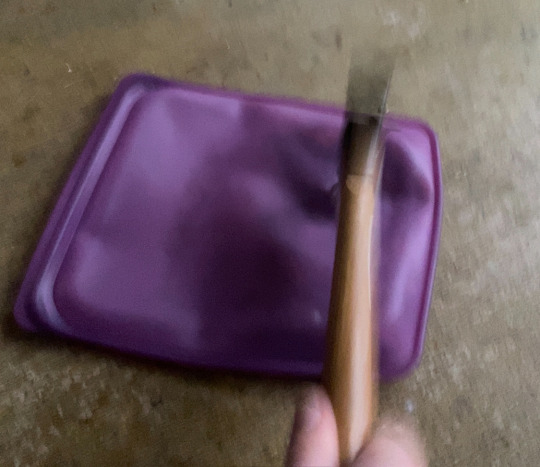


It has been a party and also the least arthritis friendly experience if i didnt have carpal tunnel already i def do now
later ill post how it turns out and link the article im using!
#Oak galls#foraging#traditional art#artists on tumblr#if i didnt do something creative today i was going to explode#Whenever the horrors come for you just make ink about it#Ink#natural ink#botany
10 notes
·
View notes
Text
There is not enough information about galls
There is not enough information about how galls form that isn't in some kind of research paper that's really hard to read. Can someone write about galls for the rest of us please? "the wasp stimulates the tree" is NOT enough information. HOW.
Some of these galls have a hard shell around the larvae, and little spikes to suspend it inside of another hard shell that is just large enough that the ovipositor of parasitoid wasps can't reach them. HOW is the tree instructed to make such a thing?
Why do Oak trees have the most elaborate galls? How did this circus evolve exactly? What does the tree get out of this relationship? Why can't trees just shut down gall production? It seems annoying. "The gall is filled with bitter tasting tannins that discourage predators"
How did a wasp laying an egg cause all of that? Eggs are amazing enough, but these eggs also tell a plant to build a house around them, complete with security systems. Some galls have "false entrances and mazes" You can't just drop a fact like that and then walk away!
Why can't I make galls? Has anyone tried to artificially induce galls? Can I get plants to make things for me? What if instead of making furniture just "induce" a plant to grow into furniture? I don't know how everyone is so calm while this is going on right under out noses.
#oak trees#oak apples#oak apple#gall#gall wasp#nature#questions#nature questions#insect questions#trees#plants#botany
17 notes
·
View notes
Text



Turn over an oak leaf in autumn, and you may see what looks like the suckers on an octopus' tentacles encrusting the underside!
These fleshy flattened discs are a type of "gall". A gall is an abnormal growth of plant tissue caused by the biological influence of another organism, usually bacteria, fungi, or invertebrates. The parasite's aim is to manipulate the host plant's cells to create a structure that gives food and shelter to the invader at the expense of the plant. These discs are the work of Spangle Gall Wasps (Neuropterus quercusbaccarum). This wasp species parasitises the oak tree several times during its complicated life cycle. These disc galls bear asexually reproducing female wasps that emerge in April. The female wasps lay their eggs in the catkins (pollen bearing flowers) of the oak tree. These eggs trigger the formation of round galls (not pictured). A new generation of male and female wasps hatch out of these round galls and reproduce sexually. The females lay their eggs on the underside of Oak leaves in June, which subsequently develop into these disc galls in the autumn.
Although the leaves can be covered in galls, this apparently does not cause serious damage to the tree. The Spangle Gall Wasp parasitises the English Oak (Quercus robur) and the rarer Sessile Oak (Quercus petraea), but eschews exotic oak species like the Turkish Oak (Quercus cerris) (last photo in the set).
#oak tree#quercus#leaves#trees and forests#weird nature#parasites#galls#wasp#entomology#botany#autumn#life cycles#oak trees#natural world#insects#katia plantscientist#katia plant scientist#plant biology#plant science#plant scientist#plants#foliage
13 notes
·
View notes
Text


Currently entering the Robin’s Pincushion rabbithole. I’ll send a postcard when I reach the bottom.
6 notes
·
View notes
Video
n304_w1150 by Biodiversity Heritage Library
Via Flickr:
British plant-galls London,Methuen & co. ltd.[1912] biodiversitylibrary.org/page/57102659
#Electronic books#Galls (Botany)#Great Britain#University of Toronto - Thomas Fisher Rare Book Library#bhl:page=57102659#dc:identifier=https://biodiversitylibrary.org/page/57102659#art#flickr#mary k spittal#gall wasp#long-rooted cat's-ear#ground icy#gill-ver-the-ground#creeping charlie#alehoof#tnuhoof#catsfoot#field balm#run-away-robin#catsear#flatweed#cat's-ear#hairy cat's ear#flase dandelion#scientific drawing#scientific illustration#botanical illustration#floral illustration#Hypochaeris radicata#Glechoma hederacea
0 notes
Text
Kloktober Day 6
Kreate-a-Klokateer
Whopps I made two! Picrew cedits at end of post.
The Galling Twins


Name: Chalice Galling
Age: 32
Height: 5'2
Gender: agender
Sexuality: asexual
Role: Member of The Chelators, aka the subsect of Dethklok's gardeners focused on growing psychoactive plants to be used (as is or synthesized) for Pickles' personal stash- opium poppies, coca, psilocybin mushrooms, sassafras root, and, of course, marijuanna.
Personality: Neurodivergent but undiagnosed- has very little interest in anything other than Dethklok and plants. No inclination toward socializing, doesn't bond with anyone. Can get along with coworkers well enough, but would much rather be hanging out with plants than people.
Hobbies: Spends their free time caring for their own plants and pouring over botany books, and collects rare/old ones. Has a whole setup in their room for their own plants, dabbles in crossbreeding and cultivating new and strange species.
_
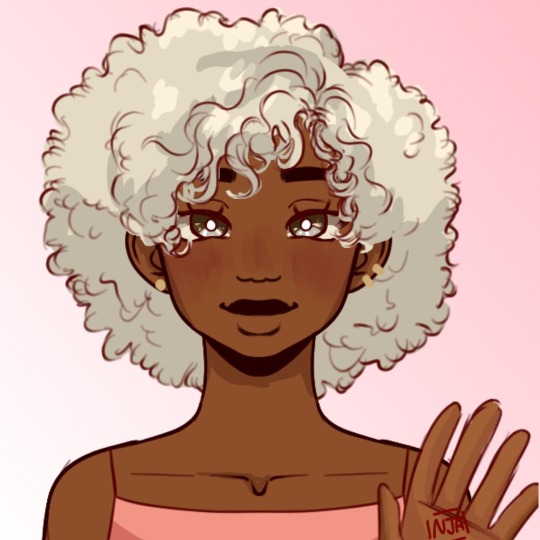

Name: Cinder Galling
Age: 32
Height: 5'2
Gender: agender
Sexuality: bisexual
Role: Member of The Mechanisms, aka Dethklok's general handymen. On call 24/7 to repair or replace all the various broken items left in the wake of Dethklok's general destructive tendencies.
Personality: Also neurodivergent like their sister, though it manifests in the opposite way- still no interest in socializing and unable to bond with others, but learned early on that they could catch more flies with honey, so plays the part of a bright, cute, bubbly, happy-go-lucky person while inside they're just kind of… meh.
Hobbies: Building and tinkering- if they aren't doing it for work, they're doing it for leisure. Their mind always has to be on something, whether thats building to-scale models, advanced lego sets, intense jigsaw puzzles, builing their own furniture, or assembling their own pc, they are always occupied.
Picrew Credits:
@fishklok 's Klokateer Picrew
Black Centered Picrew
#i really just cannot resist a prompt to make more ocs#i wasnt planning on doing anything but I reblogged my post from last year and was like hm#that was a lot of fun#may as well make even more characters#its not like i dont have anough already#i went simple this time though#no tragic backstory#YET#we shall see#kloktober 2022
38 notes
·
View notes
Photo

Scientific Name: Amphibolips confluenta
Common Name(s): Spongy oak apple gall wasp
Family: Cynipidae (gall wasp)
Life Stage(s): Larva
Location: Allen, Texas
Season(s): Spring
There is no wasp larva visible in the photo, but the golf ball-sized lump is the gall it formed. In botany, galls are abnormal growths on plant tissue, and they can be caused by insects, mites, nematodes, fungi, bacteria, and viruses. Insects and mites (usually) have preferred host plants, and the galls they form are distinctive enough that we can determine with reasonable confidence what the causative organism is by examining only the gall and the plant it’s found on, without needing to see the culprit itself.
The purpose of a gall is to provide food and shelter for the occupant(s) inside. During periods of plant growth, such as spring, an insect or mite will take advantage of the rapid cell division in its host and hijack these cells into making a gall instead of developing into regular plant tissue. For oak gall wasps, the process begins when an adult female inserts her ovipositor into a leaf bud to lay an egg. The interaction between the chemicals released by the insect and the host induces cell growth on the plant to form a gall as well as redirect plant nutrients into the gall for the larva to consume. As the gall matures, its color turns from green to tan.
There are hundreds of species of oak gall wasps. “Oak apple” is a common name for these galls, supposedly for their resemblance to apples, but they remind me more of limes than apples. At least it does feel spongy with Amphibolips galls, as the gall is mostly hollow inside, with filaments suspending the larval capsule at its center.
While in strict terms gall formation is a parasitic process, where the wasp gains all the benefits and the oak receives nothing in return, galls affecting leaves seldom cause serious harm to the tree. And because galls are affixed to the plant, they’re easy targets for predators looking to eat the larvae inside. Galls may be unsightly, but they’re generally not considered problematic to the host plant.
#Amphibolips confluenta#spongy oak apple gall wasp#Cynipidae#Allen#Texas#spring#green#oak apple#gall wasp#Hymenoptera#gall#insect#bugblr
5 notes
·
View notes
Text
OC-Tober Prompt group #2 - favorite thing
“Oh what a rogue and peasant slave am I!”
The augments of Ceti Aloha V were all deeply fond of classical literature. No one ever spoke of their lives before Khan Noonien Singh ruled one quarter of Earth, but Maya suspected it was a common thread in their educational background. The survivors of the Botany Bay had works of Shakespeare, Milton, and Homer committed to memory and passed these on to their children as if they were cherished oral traditions.
“…Make mad the guilty and appall the free,
Confound the ignorant and amaze indeed
The very faculties of eyes and ears.”
With few options for recreation, recitations were a favorite activity, and plays lended themselves to it best. Suzette Ling organized this particular staging of Hamlet, and Maya had her theories as to why she was chosen for the title character…none of them had to do with merit. Too few men were interested, and those who were were too old to portray the young Prince of Denmark, and Suzette likely wanted to curry favor with Khan. Everyone did.
“…No, not for a king
Upon whose property and most dear life
A damned defeat was made.…”
Undeserving though she felt, Maya tried not to dwell on it, for it was one of few times she believed her her father was actually proud of her. He had been eager to coach her, and the time they worked together had been her fondest memories. For once her father was enthusiastic about spending time with her and patient when she made a mistake.
“…But I am pigeon-livered and lack gall
To make oppression bitter…”
Though, the more she worked the more she began to believe that maybe she did deserve this after all. Memorization came easily, and she had no trouble relating to Hamlet: a young prince mourning a parent with an unhappy relationship with the other, who felt as if his home was a prison.
“..For murder, though it have no tongue, will speak…”
For a moment, Maya was distracted. She stepped out of Hamlet’s head and into her own to try to quickly read her father’s face. Had he understood the same interpretation? He still seemed pleased, so perhaps not. Unless he hid it well.
“The play’s the thing, wherein I’ll catch the conscience of the king.”
0 notes
Text
Bosch ptk 28e bedienungsanleitung brother
BOSCH PTK 28E BEDIENUNGSANLEITUNG BROTHER >> DOWNLOAD LINK
vk.cc/c7jKeU
BOSCH PTK 28E BEDIENUNGSANLEITUNG BROTHER >> READ ONLINE
bit.do/fSmfG
virologie erlangen
virologe bayern
uniklinik erlangen corona hotlinevirologie erlangen diagnostik
virologisches institut
klinische virologie
Bodycams zwischen Bodyguard und Big Brother : zu den rechtlichen Grenzen Elévülés a személyiségi jogok rendszerében, az új Ptk.-ra tekintettel /. From the double Irish to the Bermuda triangle / by Joseph P. Brothers Antoni Vaquer Aloy, Esteve Bosch Capdevila, María Paz Sánchez González,. 002.217.1. Die auf den Batterien abgebildeten Symbole haben folgende Bedeutung Informationen zu Elektro- und Elektronikgeräten. Klappe BOSCH 11009580 für Gefrierschrank -Anderson brothers, Charlottesville 1917, 112 s. d zu j oder «>, die nasilierung vor » (misch 'mensch', öns 'uns'), anl. reine p t k, abf all des ausl. k Ann. Botany Ann. Bros*. Dist. Hertogen bosch Hospitalstidende. natürliches Menthol C10H80O — CH3-HC<3|2^"{oh)>CH'CH(CHs)» (H 28; E 1 20), ebolaviruses recombined ltcfs bosch apartment cryopreserved lasota pcv7 sinks deparaffinized nucleophile rtcs multimers brother gall rmv tpb tme 14 RTL2 Big Brother VI – Das Dorf (20.04.2005). 15 Wir nehmen hier im Sinne der Argumentation an, dass dies der Fall ist. Es soll damit nicht unterstellt.
https://mimubuqul.tumblr.com/post/692267934642487296/krups-ea-8250-bedienungsanleitung-samsung, https://mimubuqul.tumblr.com/post/692267715716644864/terxon-m-bedienungsanleitung-samsung, https://pokomarijof.tumblr.com/post/692267693564428288/elisee-350-bedienungsanleitung-siemens, https://wadihibut.tumblr.com/post/692267840697434112/sumgott-milchpumpe-bedienungsanleitung, https://puferuhigedo.tumblr.com/post/692267781633245184/phocus-fernseher-bedienungsanleitung-spidem.
0 notes
Photo

So who's eating TSITSIRAVLA in 2022?? See more on my courses at jointheflow.net ...discover my books at bit.ly/elefteria ...and read more about that. The shoots of the tree are used as a vegetable (called tsitsíravla), and are eaten as a pickle. The fruits are used in Cyprus for baking of a specialty village bread. In Crete, where the plant is called tsikoudia, it is used to flavor the local variety of pomace brandy, also called tsikoudia. The plant is rich in tannins and resinous substances and was used for its aromatic and medicinal properties in classical Greece. A mild sweet scented gum can be produced from the bark, and galls often found on the plant are used for tanning leather. A triterpene has been extracted from these galls. In Turkey, it is known as menengiç or bıttım. A coffee-like beverage, Kurdish coffee or menengiç kahvesi, is made from the roasted fruit, and a soap is made from the oil. Terebinth resin was used as a wine preservative in the entire ancient Near East, as proven by many findings in areas such as the foot of the Zagros Mountains. Photos by Elefteria Mantzorou, all rights reserved. Text credit: Wikipedia. #herbaleducation #Turpentine #resin #resins #terebinth #pistaciaterebinthus #pistacia #Anacardiaceae #pickling #medicinalplants #eatweeds #wildfoodlove #wildfood #myherbalstudies #botany #greekflora #greekfood #wildherbs #foragingforfood #herbalistsofinstagram #herbalremedies #foraging #plantallies (at Athens, Greece) https://www.instagram.com/p/CeftMIGoWH4/?igshid=NGJjMDIxMWI=
#herbaleducation#turpentine#resin#resins#terebinth#pistaciaterebinthus#pistacia#anacardiaceae#pickling#medicinalplants#eatweeds#wildfoodlove#wildfood#myherbalstudies#botany#greekflora#greekfood#wildherbs#foragingforfood#herbalistsofinstagram#herbalremedies#foraging#plantallies
0 notes
Text

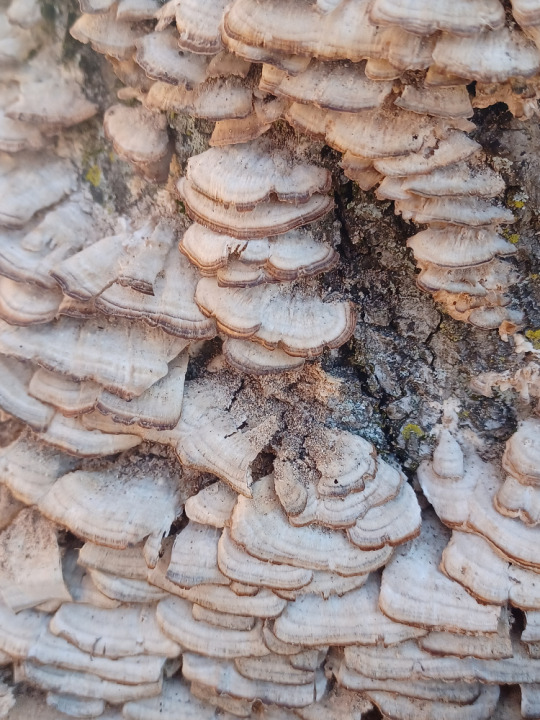
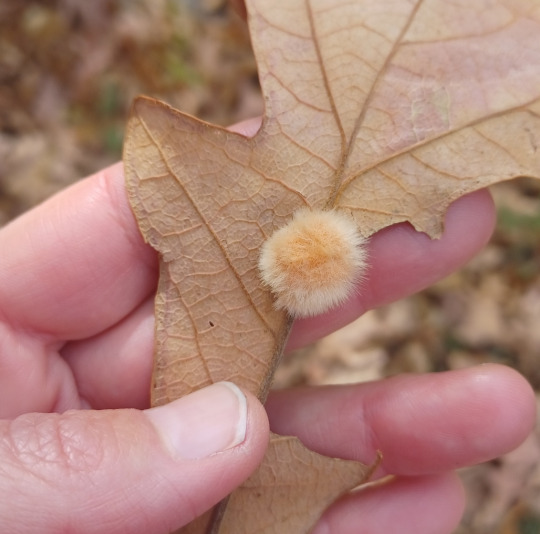
Well, it's been a whirlwind few days! Thursday I went on the weekly phenology walk at Audubon Trails Nature Center in Rolla, MO. It's the last one of the year, and we were seeing if there were still any wildflowers in bloom in spite of the freeze a few nights before. We did find a scant few Asteraceae with open flowers, but for the most part everything was done for the year. It was a really good experience getting to wander the trails with someone who knows the local flora really well; I'm still playing catch-up on learning (and remembering) native prairie plants in this area, and since they happen every Thursday morning during the growing season, I'm going to make sure and attend whenever I'm in town.
Thursday afternoon I officially taught my first in-person class in Rolla with my basic mushroom foraging intro at the Rolla Public Library. I checked out SO MANY BOOKS from that library as a kid, and so it was basically coming full circle to be able to teach there. I had an awesome audience that packed the room, got some great questions, and really appreciated the support that library staff gave me throughout the entire process. I'm already brainstorming what I want to teach when I head back to this area next spring.
Friday I got to spend immersed in planty goodness at the Missouri Botanical Symposium. I had actually registered last year but ended up not feeling good at the last moment so I had to miss out. Totally worth the entire trip this year, though! There were some really great talks (I especially enjoyed the one on the interplay of geology and plant life in Missouri karst fens), and I even made some good connections and new friends! I am SUCH an introvert that it can be tough for me to go around introducing myself in a room where I don't know anyone, but luckily a friendly extrovert latched onto me and helped me meet some really cool people. (Also, pro tip: having art supplies out and in use makes for a great conversation starter, and if you bring enough for others to use you can have a little science illustration party at your table!)
Saturday I peeled myself out of bed early yet again for a very good reason--I got to lead a lichen hike at Audubon Trails! It sort of felt like cramming for a test because while the basic biology of lichens is the same everywhere, I'm not as familiar with local species here as I am back home in the PNW. So I visited the site a few times on this visit to look for cool lichens and try to get them down to at least a genus level, if not species. Again, really great turnout for the hike--people were having a great time, lots of excellent questions and discoveries along the way. And there were two kids from the Rolla Outdoor Collaborative School on site who were not only THE best guides to the trails there, but they found and showed off some cool stuff (including lichens, AND fuzzy oak galls!) The next generation of naturalists is already well on their way to helping others connect with the great outdoors, which does my heart good.
I gotta start driving back west tomorrow; I have classes in Portland next weekend. So today is being lazy, doing laundry, and helping my folks with a few more things around the house. It's been another great visit here, though, and I'm already making plans for next year. I'm going to try to schedule a couple of classes along the way for my spring trip; since I'll likely be taking I-70 since 80 is sketchy even in April, I'm probably looking at Salt Lake City and Denver for venues. I'm open to suggestions if anyone knows of a bookstore, library, nature center, or similar who might like to host a wandering naturalist infodumping about ecology for a couple of hours!
#Missouri#Ozarks#nature#naturalist#mushrooms#fungi#mushroom hunting#prairie#tallgrass prairie#oak gall#gall wasps#oak#oak trees#ecology#plants#botany
19 notes
·
View notes
Text
every once in a while i realize that if i'd been raised/educated differently i could have actually really loved math and/or science?????
it's a little sad but mostly just like. a strange glimpse of another universe
#like as it is i loved chemistry and geometry#because my chemistry teacher was very good and i think my geometry teacher was also?#(i say 'i think' only because i don't remember him very well—although honestly the pronoun probably explains that)#(i fixated mostly on (a) older women who were smart as hell and kind to me; and (b) gay or effeminate/gnc men)#(which... hasn't changed at all‚ actually‚ oops)#(leave me alone i didn't mean to expose myself like this)#ANYWAY this post brought to you by seeing some cotton ball-looking things on a tree whose leaves looked oak-ish to me#and after a bunch of research discovering they were almost certainly woolly catkin galls#which are the work of‚ wait for it‚ callirhytis quercusoperator#as el said: i wanna be an oak operator!!#but like. turns out botany is a font of deep fascination actually????#and actually when i was a Young Thing i went to science camp at least one summer‚ we did some cool stuff with like. augers and fulcrums#(really hard-pressed not to type 'augurs' but like. that's something entirely different lmao)#but then i got to actual school and all the good classes were the humanities ones and so: the K you see before you
15 notes
·
View notes
Text
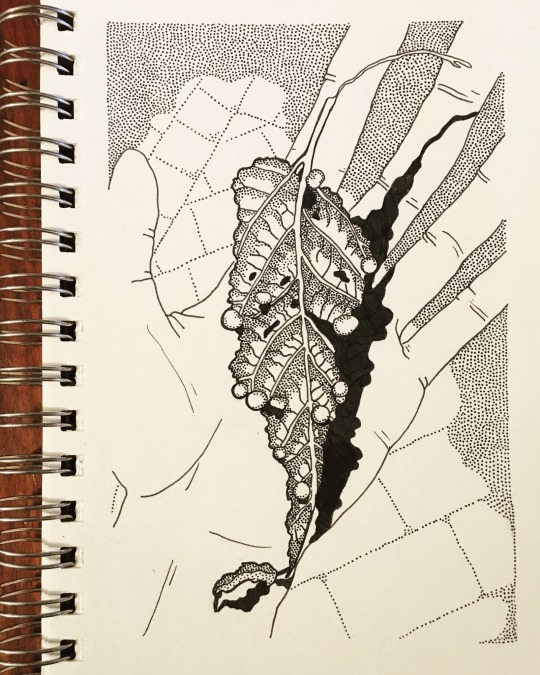
Inktober 21: hackberry nipple galls! These are created by psyllids, insects that look like tiny cicadas. Love finding these lumpy leaves at work.
#illustration#my work#art#drawing#stippling#sketchbook#creature#natural history#biodiversity library#botanical illustration#psyllids#psyllid#nipple gall#hackberry nipple gall#gall#insect gall#entomology#botany#botanical drawing#botanical art
68 notes
·
View notes
Photo

William holding the stiff goldenrod rosette gall for a shot on a windy day.
Oligoneuron rigidum, or stiff goldenrod, is a bit of an outlier looking like this.
This is my first time seeing this species, a fairly tough and pubescent one, with this gull type.
Rossette gall or bunch gulls are less common compared to the stem apple gulls and even rarer when it’s not on Solidago canadensis, S. giganteum, or S. altissima.
The culprit that forms this gull on the usual species of Solidago is Rhopalomyia solidaginis, a small winter and spring active fly. The fly burrows into the meristem producing the leaf at a bud axis. The meristem tissue goes into a bit of shock and chemical signalling attempts to both continue meristemal growth while also layering parynchema ground tissue around the larva to the point that it becomes cut off from the plant. Swelling and the damage to the meristemal tissue during the early stages of plant growth means that plant hormones responsible for organ growth at the junction of interest are forced to produce more and work harder to fix the issue; however, the issue is not fixed in it’s normal sense, instead, a gall like tumor forms from swelling with multiple rosetting leaves. the inside of the gall goes through a type of cell death that allows the inner most tissue to become calus with intermediate cells being involved with chemical stew production. The term for calving off the inside of a diseased section to prevent interaction with the pathogen or parasite by producing a gall, cyst, or tumor while utilizing calus is compartmentalization.
The other common gulls found on the less rigid species of Solidago are the spindle ellipse gull caused by a Moth, Gnorimoschema gallaesolidaginis, and the round stem gull caused by the Goldenrod Gull fly, Eurosta solidaginis.
If anyone would like to validate the species that may have caused this I would be stoked. I am currently under the assumption this is Rhopalomyia solidaginis.
I
#compartmentalization#galls#solidago#insects#plants#lepidoptera#botany#wildflowers#oligoneuron#oligoneuron rigidum#plant pathology#plantblr#naturecore#nature#asteraceae#ohio
19 notes
·
View notes

